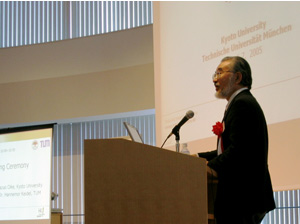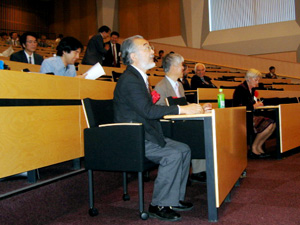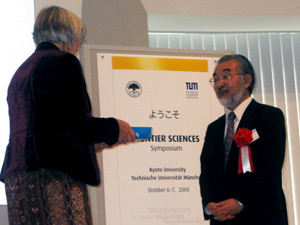Kazuo OIKE

Good morning, ladies and gentlemen. As a president of Kyoto University, I would like to express my deepest gratitude to all of you who have come to attend this FRONTIER SCIENCES Symposium. This is a collaborative joint event by Technische Universitat Munchen and Kyoto University. It is my great honor to welcome Vise President Dr. Hannemor Keidel of TUM and all the distinguished guests from universities, companies and Japan-Germany friendship organizations to our Kyoto University.
As you know, a program of Deutschlandyahr in Japan 2005-2006 is in our country now and more than 300 events are held in various regions to introduce Germany cultures, economics and scientific technologies. It's a great pleasure and honor to us that TUM chose our university as a partner to hold the celebration of presenting frontier sciences in TUM to Japan as a part of this magnificent program.
Since the Meiji Era of 1860's, Germany and Japan have nurtured a nation-wide intellectual and cultural exchange and cooperation, establishing very strong bonds between the two countries. In addition to the traditional specialized fields such as legal science, medical science, literature and philosophy, mutual exchange in the areas of natural science and technologies are of increasing importance for the two countries. Actually, about 200 strong partner relationships has been formally established between German and Japanese universities, and inter-universities level agreements are exchanged by 36 universities in Japan. Many research collaborations are undertaken in the area of energy science, high-energy physics, reactor safety technology, environmental conservation, mental science, ocean and resources research and information technology. Thus, mutual cooperative ties between Germany and Japan are covering almost all the key areas of science and technologies.

As for tuition reimbursement programs, DAAD (Deutscher Akademischer AustauschDienst) is promoting research cooperation between Germany and Japan through assistance in scholarships. The Alexander von Humboldt Foundation is doing much for international research cooperation, enabling highly qualified Japanese scholars to spend extended periods of research in Germany and promoting the ensuing academic contacts. JSPS (Japan Society for the Promotion of Science) is also promoting exchange among universities in Japan and Germany by supporting the reciprocal student enrollment in the two countries. We are delighted to know that many Japanese scholars and students are active internationally in various academic fields based on their experiences gained in Germany. I would like to sincerely respect to alumni associations such as DAAD Tomo no kai, Vereinigung der Humboldtianer in Ost- and West-Japan, and other organizations for their efforts to promote the academic exchange between the two countries.
For over 1,000 years, Kyoto was the capital of Japan, the heart of culture and politics. Kyoto is further unique within Japan in that it was virtually untouched during World War II, leaving a myriad of temples, shrines and a castle intact. This legacy has been recognized by UNESCO, which has designated 17 separate sites within Kyoto's borders as World Cultural Heritage sites. Additionally, 20% of Japan's national treasures and 15% of the country's cultural properties can all be found in Kyoto.
Kyoto University was founded in 1897. It is the second oldest national university in Japan, and is regarded as a prestigious large-scale research university, housing 16 graduate schools, 10 faculties, 13 research institutes, and 19 other research centers. The most outstanding feature of Kyoto University's academic traditions is a respect for the spirit of freedom and independence characteristics, which arise from Kyoto's cultural and philosophical traditions. Throughout its history spanning more than 100 years, the university has gained an excellent reputation for its scientific achievements and academic activities in various disciplines. It is well known that half of all Japanese Nobel Prizewinners have mostly come from Kyoto University in the fields of theoretical physics, chemistry and molecular biology. A dedication to fieldwork is one of the unique features of Kyoto University. For example, the Primate Research Institute is a key center for field sciences within the university, and we have important key stations in several countries in the Asia and Africa regions.

Concerning with academic exchanges with Germany, there has been a long history, and Kyoto and our university have played an important role in fostering Japan-Germany friendships. In 1933, Deutsches Kulturinstitut was established at Kyoto by Ichiro Hatoyama, Minister of Education at the time. After the World War II, that was temporarily closed, but in 1956 it was reestablished as Japanish-Deutsches Kulturinstitut with the endeavors of Faculty of medicine of Kyoto University. Professor emeritus Shin-ichi Matsumoto was the first president of the institute. In 1964, Goethe-Institut Kyoto was established in Japanish-Deutsches Kulturinstitut, which was moved to the current location close to our main campus in 1983.
The academic exchange between TUM and Kyoto University is very active, and many researchers are collaborating with your faculties making mutual visits and holding many joint academic meetings. It is our pleasure that those collaborative efforts bear fruit as six workshops that will be held in our three campuses tomorrow with the participants from both universities. Four graduate schools of Kyoto University, that is, Graduate Schools of Engineering, Energy Science, Informatics, and Global Environmental Studies, have undertaken Faculty-Level Academic Exchange Memorandum Partnerships with TUM. In addition, Kyoto University has undertaken University-Level Academic Exchange Memorandum Partnerships with 57 universities and 3 university groups of 23 countries at present. I believe that our international academic networks will be further expanded in years to come.
After this opening ceremony, the presentations on TUM and Kyoto University will be made, and frontier sciences ongoing at both universities will be introduced in the afternoon. Funding possibilities for student and academic exchange will be also presented by DAAD, the Humboldt Foundation and JSPS. I find it of great significance that this symposium will provide with occasions to know with each other and to find new partners. Tomorrow, six workshops will be held at our three campuses, and all of the topics discussed therein are of great promise and importance in future science and technology. It is my fervent wish that exchanging ideas through those workshops will contribute to foster the cooperative relationships between TUM and Kyoto University more deeply and further advanced joint researches will be launched on.
Finally I would like to express my sincere thanks to Vise President Dr. Hannemor Keidel of TUM and Vise President Prof. Mitsuhiko Araki for their endeavors to arrangements necessary to make this joint event a most outstanding occasion. My sincere thanks are extended to all those who have made this symposium possible. I would like to extend a warm welcome to the participants, and hope you take advantage of seeing our historical city of Kyoto while you are here and enjoy all the sights it affords in early autumn.
Thank you for your attention.

